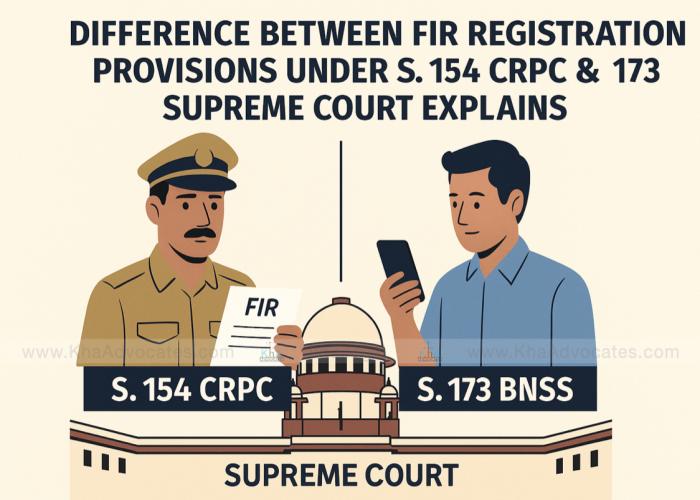
Published on: May 24, 2025
With the introduction of the Bharatiya Nagarik Suraksha Sanhita, 2023 (BNSS), the traditional provisions under the Criminal Procedure Code, 1973 (CrPC) have undergone significant restructuring. One of the most fundamental and commonly invoked sections in criminal jurisprudence—Section 154 CrPC, dealing with FIR registration—now finds a parallel in the new Section 173 of the BNSS. This article examines the core differences between these two provisions and highlights key clarifications made by the Supreme Court regarding FIR registration, citizens’ rights, and police obligations under the new legal framework.
Section 154 of the CrPC defines the process of registering a First Information Report (FIR) when information regarding a cognizable offence is brought to the notice of the police. It lays down three core principles:
Mandatory Registration: In cases involving cognizable offences, police must register an FIR without conducting a preliminary inquiry.
Written & Signed by Informant: The information must be recorded in writing, read over to the informant, and signed by them.
Copy to Informant: A copy of the FIR is to be provided free of cost.
This section has been interpreted in various landmark judgments (e.g., Lalita Kumari v. Govt. of U.P.), reinforcing the obligation of the police to register FIRs promptly without unwarranted delay or discretion.
Section 173 of the BNSS, 2023, redefines and reorders several procedural elements of FIR registration. While the intent and structure remain broadly aligned with Section 154 CrPC, there are a few crucial differences:
Use of Technology: BNSS explicitly promotes the use of electronic means for filing information. Citizens can now submit details of cognizable offences through digital platforms, increasing accessibility.
Timelines & Accountability: BNSS introduces stricter time-bound processes for police action post-FIR registration, reinforcing accountability and transparency in investigations.
Digital Documentation: BNSS focuses on the digitization of records, ensuring that FIRs, signatures, and subsequent actions are documented through an online tracking mechanism for transparency and traceability.
Public Safety Focus: The BNSS provisions reflect a shift toward citizen-centric policing, emphasizing service delivery, protection of victim rights, and systemic efficiency.
In recent commentary, the Supreme Court addressed the parallel existence and transition from Section 154 CrPC to Section 173 BNSS. The Court emphasized that the underlying objective remains the same: prompt and fair registration of FIRs in cognizable cases. However, the Court also observed:
Ease of Access: The digital features under BNSS remove bureaucratic hurdles, especially for citizens in remote or rural areas.
Checks on Police Discretion: The Supreme Court reiterated that police authorities must not delay FIR registration under the pretext of conducting preliminary inquiries unless mandated by law.
Victim-Centric Justice: The judiciary stressed the BNSS’s inclination toward protecting victim rights by ensuring procedural speed, technological inclusion, and time-bound investigation.
Aspect | Section 154 CrPC | Section 173 BNSS | ||||||||||
|---|---|---|---|---|---|---|---|---|---|---|---|---|
FIR Filing Mode | Written/Oral at police station | Includes digital submission | ||||||||||
Mandatory FIR for Cognizable | Yes | Yes | ||||||||||
Technology Integration | Limited | Strong emphasis on digitization | ||||||||||
Timelines for Police Action | Broad and case-law dependent | Defined statutory timelines | ||||||||||
Victim Support Provisions | Minimal procedural support | Enhanced victim-centric procedures | ||||||||||
Public Awareness/Access | Physical, often opaque | Digital, transparent tracking system |
The transition from Section 154 CrPC to Section 173 BNSS marks a pivotal shift in criminal justice reform in India. While the foundational principles of FIR registration remain intact, BNSS introduces much-needed modernization, accountability, and technological accessibility. The Supreme Court’s interpretation reinforces the constitutional guarantee of prompt and fair investigation and affirms the legislature’s intent to bring procedural law in step with 21st-century policing standards.
As India gradually implements BNSS, legal practitioners, police authorities, and citizens alike must familiarize themselves with the evolving framework to ensure the effective protection of rights and delivery of justice.
